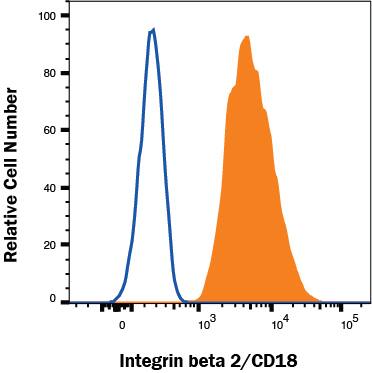Human Integrin beta2/CD18 Biotinylated Antibody
R&D Systems, part of Bio-Techne | Catalog # BAF1730


Key Product Details
Species Reactivity
Validated:
Cited:
Applications
Validated:
Cited:
Label
Antibody Source
Product Specifications
Immunogen
Gln23-Asn700
Accession # AAA59490
Specificity
Clonality
Host
Isotype
Scientific Data Images for Human Integrin beta2/CD18 Biotinylated Antibody
Detection of Integrin beta2/CD18 in THP-1 cells by Flow Cytometry
THP-1 cells were stained with Goat Anti-Human Integrin beta2/CD18 Biotinylated Antigen Affinity-purified Polyclonal Antibody (Catalog # BAF1730, filled histogram) or isotype control antibody (Catalog # BAF108, open histogram) followed by Streptavidin-Allophycocyanin (Catalog # F0050). View our protocol for Staining Membrane-associated Proteins.Applications for Human Integrin beta2/CD18 Biotinylated Antibody
Flow Cytometry
Sample: THP-1 human acute monocytic leukemia cell line
Western Blot
Sample: Recombinant Human Integrin alphaX beta2 (Catalog # 5755-AX)
Formulation, Preparation, and Storage
Purification
Reconstitution
Formulation
Shipping
Stability & Storage
- 12 months from date of receipt, -20 to -70 °C as supplied.
- 1 month, 2 to 8 °C under sterile conditions after reconstitution.
- 6 months, -20 to -70 °C under sterile conditions after reconstitution.
Background: Integrin beta 2/CD18
Integrin alphaX beta2, also called CD11c/CD18, p150/95 or complement receptor type 4 (CR4), is one of four beta2 integrins. The non-covalent heterodimer of 150 kDa alphaX/CD11c and 95 kDa beta2/CD18 integrin subunits is expressed on macrophages, dendritic cells, and hairy cell leukemias, with lower amounts on other myeloid cells and activated B, NK, and some cytotoxic T cells (1-7). Like other integrins, alphaX beta2 has multiple activation states (3). In the presence of divalent cations and "inside-out" signaling, alphaX beta2 is fully active and extended. The alphaX vWFA or I-domain, which contains the adhesion sites, forms the N-terminal head region with the alphaX beta-propeller and the beta2 vWFA domain (1, 8). In the inactive state, the heterodimer flexes in the center at the alphaX thigh and calf domains and beta2 I-EGF domains, impeding access to adhesion sites (1). The 1088 aa human alphaX/CD11c ECD shares 70-76% amino acid (aa) sequence identity with mouse, rat, and canine alphaX while the 678 aa human beta2/CD18 ECD shares 81-83% aa sequence identity with mouse, rat, cow, dog, goat, sheep, and pig beta2. Potential alphaX isoforms containing 719 and 725 aa (as compared to full-length 1163 aa alphaX) lack the vWFA domain and the N-terminus. Active alphaX beta2 shares some adhesion partners with alphaM beta2/CD11b/CD18, including complement opsonin fragment iC3b, ICAMs, vWF, and fibrinogen, and is expressed on many of the same cells (4-11). However, alphaM beta2 activity is often constitutive, while alphaX beta2 activity requires cell activation (4-7). alphaX beta2 also binds osteopontin, Thy-1, plasminogen, heparin, and proteins with abnormally exposed acidic residues (11-16). The adhesion events are important for proliferation, degranulation, chemotactic migration, and phagocytosis of complement-opsonized particles (5, 6, 9, 11, 12, 16). Mutations of beta2, especially in the vWFA domain, cause leukocyte adhesion deficiency (LAD-1) and susceptibility to bacterial infections (17).
References
- Corbi, A.L. et al. (1987) EMBO J. 6:4023.
- Kishimoto, T.K. et al. (1987) Cell 48:681.
- Hynes, R.O. (2002) Cell 110:673.
- Arnaout, M.A. (1990) Blood 75:1037.
- Postigo, A.A. et al. (1991) J. Exp. Med. 174:1313.
- Beyer, M. et al. (2005) Respir. Res. 6:70.
- Nicolaou, F. et al. (2003) Blood 101:4033.
- Vorup-Jensen, T. et al. (2003) Proc. Natl. Acad. Sci. USA 100:1873.
- Bilsland, C.A.G. et al. (1994) J. Immunol. 152:4582.
- Pendu, R. et al. (2006) Blood 108:3746.
- Sadhu, C. et al. (2007) J. Leukoc. Biol. 81:1395.
- Schack, L. et al. (2009) J. Immunol. 182:6943.
- Choi, J. et al. (2005) Biochem. Biophys. Res. Commun. 331:557.
- Gang, J. et al. (2007) Mol. Cells 24:240.
- Vorup-Jensen, T. et al. (2007) J. Biol. Chem. 282:30869.
- Vorup-Jensen, T. et al. (2004) Proc. Natl. Acad. Sci. USA 102:1614.
- Kishimoto, T.K. et al. (1987) Cell 50:193.
Alternate Names
Gene Symbol
UniProt
Additional Integrin beta 2/CD18 Products
Product Documents for Human Integrin beta2/CD18 Biotinylated Antibody
Product Specific Notices for Human Integrin beta2/CD18 Biotinylated Antibody
For research use only